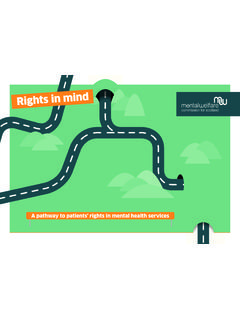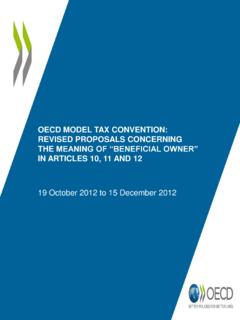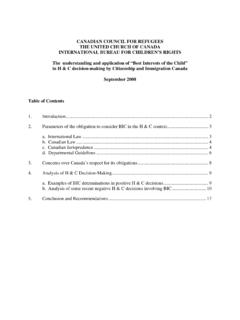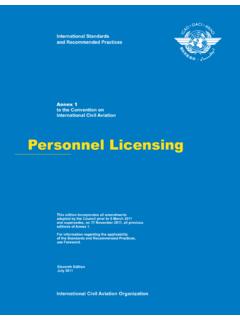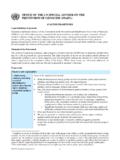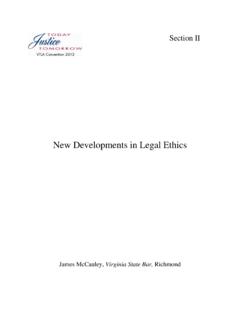Transcription of Guidelines on Pesticide Legislation
1 International Code of Conduct on Pesticide Management Guidelines on Pesticide Legislation September 2015. The Inter-Organisation Programme for the Sound Management of Chemicals (IOMC) was established in 1995 following recommendations made by the 1992 UN Conference on Environment and Development to strengthen cooperation and increase international coordination in the field of chemical safety. The participating organizations are the Food and Agriculture Organization of the United Nations (FAO), the International Labour Organization (ILO), the Organisation for Economic Co-operation and Development (OECD), the United Nations Environment Programme (UNEP), the United Nations Industrial Development Organization (UNIDO), the United Nations Institute for Training and Research (UNITAR) and the World Health Organization (WHO). The World Bank and the United Nations Development Programme (UNDP) are observers. The purpose of the IOMC is to promote coordination of the policies and activities pursued by the participating organizations, jointly or separately, to achieve the sound management of chemicals in relation to human health and the environment.
2 This publication was developed in the IOMC context. The contents do not necessarily reflect the views or stated policies of individual IOMC participating organizations. The designations employed and the presentation of material in this publication do not imply the expression of any opinion whatsoever on the part of the Food and Agriculture Organization of the United Nations (FAO) or of the World Health Organization (WHO). concerning the legal status of any country, territory, city or area or of its authorities, or concerning the delimitation of its frontiers or boundaries. Dotted lines on maps represent approximate border lines for which there may not yet be full agreement. The mention of specific companies or products of manufacturers, whether or not these have been patented, does not imply that these are or have been endorsed or recommended by FAO or WHO in preference to others of a similar nature that are not mentioned. Errors and omissions excepted, the names of proprietary products are distinguished by initial capital letters.
3 All reasonable precautions have been taken by FAO and WHO to verify the information contained in this publication. However, the published material is being distributed without warranty of any kind, either expressed or implied. The responsibility for the interpretation and use of the material lies with the reader. In no event shall FAO and WHO be liable for damages arising from its use. The views expressed herein are those of the authors and do not necessarily represent those of FAO or WHO. FAO and WHO, 2015. FAO and WHO encourage the use, reproduction and dissemination of material in this information product. Except where otherwise indicated, material may be copied, downloaded and printed for private study, research and teaching purposes, provided that appropriate acknowledgement of FAO and WHO as the source and copyright holder is given and that FAO and WHO's endorsement of users' views, products or services is not implied in any way. E-ISBN 978-92-5-108896-8.
4 All requests for translation and adaptation rights, and for resale and other commercial use rights should be made via or addressed to FAO information products are available on the FAO website ( ) and can be purchased through ii Table of Contents ABBREVIATIONS .. V. 1. INTRODUCTION .. 1. 2. REASONS FOR UPDATING Pesticide Legislation .. 4. 3. THE PROCESS OF DRAFTING Pesticide Legislation .. 6. STEPS IN REVISING OR DRAFTING Pesticide 6. THE Pesticide LIFE CYCLE AND ITS REGULATORY 7. CONSISTENCY WITH THE NATIONAL LEGAL 7. 4. ELEMENTS OF A NATIONAL Pesticide LAW .. 8. INTRODUCTORY PROVISIONS .. 8. Preamble and objectives .. 8. Scope .. 8. 9. 10. General institutional structure .. 10. Pesticide Registration Board .. 12. Pesticide Registrar .. 13. Pesticide advisory bodies .. 13. REGISTRATION .. 14. Application procedure .. 16. Data 16. Decision-making 17. Registration decisions .. 18. Re-registration .. 20. Modification of the registration data .. 20. Review.
5 20. Record-keeping and confidentiality .. 21. IMPORT AND EXPORT .. 22. LICENSING .. 25. General requirements for licenses .. 26. Licensing for manufacture and formulation of pesticides .. 27. Licensing for storage of 27. Licensing for sale of pesticides .. 28. Licensing of commercial 29. Specific uses .. 29. Other license schemes .. 30. PACKAGING AND 30. LABELLING .. 32. USE .. 34. ADVERTISING .. 35. STORAGE, TRANSPORT AND DISPOSAL .. 37. Storage .. 37. Transport .. 38. Disposal .. 39. INFORMATION COLLECTION AND MONITORING .. 41. iii INCIDENT REPORTING .. 42. 43. OFFENCES AND PENALTIES .. 45. Offences .. 45. Penalties .. 47. Rights and appeals related to enforcement procedures .. 47. MISCELLANEOUS AND FINAL PROVISIONS .. 48. Presumptions .. 48. Repeals, savings and transitional clauses .. 48. Power to make regulations .. 48. Implementing Legislation .. 49. 5. CONSIDERATIONS IN DESIGNING NATIONAL 50. INTERNATIONAL FRAMEWORK .. 50. Binding international 50.
6 Non-binding international instruments .. 54. Meeting supra-national obligations .. 55. REGIONAL 56. NATIONAL CONTEXT .. 57. Constitution .. 58. Other national Legislation .. 58. Policies .. 59. Implementation .. 60. 6. FINAL REMARKS .. 61. iv Abbreviations CWC Chemical Weapons Convention CAC Codex Alimentarius Commission CCPR Codex Committee on Pesticide Residues DNA Designated National Authority (Rotterdam Convention). FAO Food and Agriculture Organization of the United Nations GHS Globally Harmonized System of Classification and Labelling of Chemicals HHP Highly Hazardous Pesticide ILO International Labour Organization IPM Integrated Pest Management IPR Intellectual Property Rights IVM Integrated Vector Management MRL Maximum Residue Limit OECD Organization for Economic Co-operation and Development PCO Pest Control Operator PIC Prior Informed Consent POP Persistent Organic Pollutant SDS Safety Data Sheet UNEP United Nations Environment Programme WHO World Health Organization WTO World Trade Organization v Explanation of key legal terms used throughout this document The regulatory framework for the control of pesticides encompasses the full set of different types of Legislation governing the management of pesticides .
7 Besides Pesticide Legislation (see below), this may for instance include Legislation on environmental protection, public health, occupational health, water, food safety, wildlife, marine protection, plant protection and general chemicals management. The regulatory framework also includes obligations under international instruments. Pesticide Legislation refers to legal instruments specifically designed to control pesticides . The term, Pesticide Legislation , may refer to a primary instrument, often a Law, Act or Ordinance, as well as a number of secondary or subsidiary legal instruments, such as Regulations, Decrees, Rules or Notices. The Pesticide Law, or similar primary instrument, provides the core part of the Pesticide Legislation . It establishes principles, mandates and responsibilities. Its adoption generally involves parliamentary approval. Pesticide Regulations, or other secondary Legislation (also referred to as subsidiary Legislation or implementing Legislation ), further regulate specific areas of the Pesticide Law in greater detail.
8 Generally, these can be issued at Ministerial level. Further details are provided in paragraph vi 1. Introduction International and national legal frameworks governing Pesticide management have undergone significant changes over the past 25 years. The International Code of Conduct on the Distribution and Use of pesticides was adopted by FAO in 1985. It was subsequently amended in 1989 to include the prior informed consent (PIC) procedure and revised in 2002. In 2013, it was updated to include public health pesticides and its title was changed to The International Code of Conduct on Pesticide Management (Code of Conduct). In 2014, the WHO also adopted the Code of Conduct as its reference framework for international guidance on Pesticide management. Since the first adoption of the Code of Conduct in 1985, several other international instruments dealing directly or indirectly with pesticides or Pesticide management have come into force. The most important of these are the Rotterdam Convention on the Prior Informed Consent Procedure for Certain Hazardous Chemicals and pesticides in International Trade (Rotterdam Convention), the Stockholm Convention on Persistent Organic Pollutants (Stockholm Convention), the Basel Convention on the Transboundary Movement of Hazardous Wastes and their Disposal (Basel Convention), the Montreal Protocol on Substances that Deplete the Ozone Layer (Montreal Protocol) and the International Labour Organisation Convention No.
9 184 on Safety and Health in Agriculture (ILO Convention 184). Other relevant developments have included the launch of a Strategic Approach to International Chemicals Management (SAICM) and the adoption of a new Globally Harmonized System of Classification and Labelling of Chemicals (GHS), which is intended to standardize and harmonize the classification and labelling of chemicals. At the time the Code of Conduct was first published, most developing countries and countries with economies in transition did not have Pesticide Legislation in place. Awareness of the hazards of pesticides was limited, while the use of pesticides , including highly toxic products, was increasing. Significant progress has been made since then, and now almost every country has some type of Legislation covering pesticides . However, many of the existing laws have weaknesses. For example, they may not sufficiently reflect the requirements of international agreements or regional initiatives to harmonize requirements, or they may not be adequately connected to new national Legislation on environmental protection, chemicals management, or other relevant areas.
10 Changes in the institutional framework and associated mandates may not have been addressed. Other common issues include outdated penalties and the absence of a clear assignment of authority to enforce the Legislation . Requirements of various binding international agreements as well as the numerous recommendations of non-binding instruments can place a heavy burden on small or resource- poor ministries or departments in charge of Pesticide management and regulation. Little comprehensive advice is available to assist countries with understanding which rules are binding or non-binding and which should or could be reflected in national pesticides Legislation . The purpose of these Guidelines is to provide guidance to governments that seek to review, update or design national Pesticide Legislation . 1 It should be emphasized, however, that 1. This guideline covers Legislation directly regulating pesticides , not Legislation covering the control of Pesticide residues, which properly belongs in a country's food safety Legislation .












